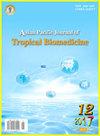Melatonin alleviates oxidative stress, inflammation, apoptosis, and DNA damage in acrylamide–induced nephrotoxicity in rats
IF 1.7
4区 医学
Q3 TROPICAL MEDICINE
引用次数: 0
Abstract
Objective: To investigate the effects of melatonin on renal inflammation, oxidative stress, apoptosis, as well as DNA and tissue damage in acrylamide-induced nephrotoxicity in rats. Methods: Fifty male rats were randomly divided into five groups. The control group received distilled water by gastric lavage for 11 days and the acrylamide group was administered acrylamide (50 mg/kg, i.g.) for 11 days. The MEL10+ACR and MEL20+ACR groups received intraperitoneal melatonin 10 and 20 mg/kg, respectively, for 11 days, and acrylamide (50 mg/kg, i.g.) was administered 1 h after melatonin injection. The MEL20 group was injected with melatonin (20 mg/kg) for 11 days. Kidney function tests were performed and biochemical and inflammatory parameters were determined. In addition, histopathological, immunohistochemical, and immunofluorescence examinationswerecarried out. Results: Melatonin significantly abated acrylamide-induced rise in serum urea and creatinine levels. Acrylamide caused oxidative stress, inflammation, apoptosis, as well as DNA and tissue damage in the kidneys. Melatonin treatment alleviated acrylamide-induced renal damage by exhibiting antioxidant, anti-inflammatory, and anti- apoptotic effects. Moreover, melatonin significantly ameliorated acrylamide-caused histopathological changes in kidney tissue. Conclusions: Melatonin attenuates acrylamide-induced renal oxidative stress, inflammation, apoptosis, and DNA damage in rats.褪黑素可减轻丙烯酰胺肾毒性大鼠的氧化应激、炎症、细胞凋亡和DNA损伤
目的:探讨褪黑素对丙烯酰胺肾毒性大鼠肾脏炎症、氧化应激、细胞凋亡及DNA和组织损伤的影响。方法:50只雄性大鼠随机分为5组。对照组灌胃蒸馏水11 d,丙烯酰胺组灌胃丙烯酰胺50 mg/kg,灌胃11 d。MEL10+ACR组和MEL20+ACR组分别腹腔注射褪黑素10和20 mg/kg,连续11 d,褪黑素注射1 h后ig丙烯酰胺50 mg/kg。MEL20组小鼠注射褪黑素(20 mg/kg) 11 d。进行肾功能检查,并测定生化和炎症参数。此外,还进行了组织病理学、免疫组织化学和免疫荧光检查。结果:褪黑素显著降低丙烯酰胺引起的血清尿素和肌酐水平升高。丙烯酰胺会引起氧化应激、炎症、细胞凋亡以及肾脏的DNA和组织损伤。褪黑素治疗可通过抗氧化、抗炎和抗凋亡作用减轻丙烯酰胺引起的肾损伤。此外,褪黑素显著改善丙烯酰胺引起的肾组织病理改变。结论:褪黑素可减轻丙烯酰胺诱导的大鼠肾脏氧化应激、炎症、细胞凋亡和DNA损伤。
本文章由计算机程序翻译,如有差异,请以英文原文为准。
求助全文
约1分钟内获得全文
求助全文
来源期刊

Asian Pacific journal of tropical biomedicine
Biochemistry, Genetics and Molecular Biology-Biochemistry, Genetics and Molecular Biology (miscellaneous)
CiteScore
3.10
自引率
11.80%
发文量
2056
审稿时长
4 weeks
期刊介绍:
The journal will cover technical and clinical studies related to health, ethical and social issues in field of biology, bacteriology, biochemistry, biotechnology, cell biology, environmental biology, microbiology, medical microbiology, pharmacology, physiology, pathology, immunology, virology, toxicology, epidemiology, vaccinology, hematology, histopathology, cytology, genetics and tropical agriculture. Articles with clinical interest and implications will be given preference.
 求助内容:
求助内容: 应助结果提醒方式:
应助结果提醒方式:


